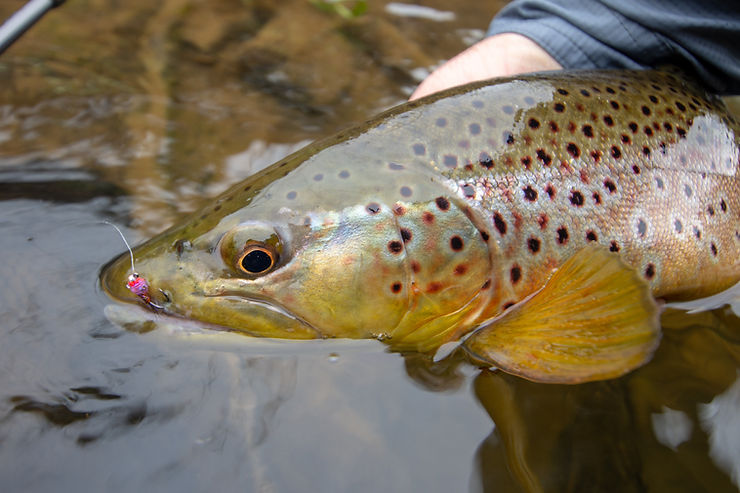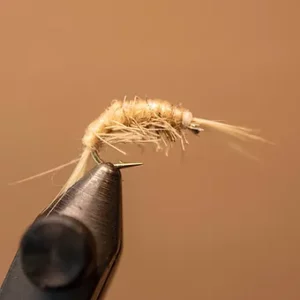Make Mine A Frenchie

The Frenchie is a simple variation of the Pheasant Tail that includes a hot spot in place of a wing case and peacock thorax. As you probably guessed by the name, it was first developed by the French and popularized here in the United States by competitive angler Lance Egan, thus this fly is sometimes referred to as Egan’s Frenchie.
I’ve seen this fly tied in a variety of styles, and on a variety of hooks, but my favorite variation is tied on a jig hook with a slotted tungsten gold bead. Also, you can use almost any hackle fibers for the tail, or just use pheasant tail, but several strands of Coq De Leon are typically more durable.
However, due to the pandemic, there has been a chronic shortage in certain fly tying materials, one of which seems to be CDL tailing hackle in both Light Speckled Pardo and Medium Speckled Pardo, the colors of choice for most nymph tails. But don’t let that stop you from tying this pattern. Grizzly hackle fibers or natural wood duck flank work just as well.

Here’s the recipe for the Frenchie:
Hook: Size 12-18 jig-style barbless hook
Thread: Red
Tail: CDL tailing fibers
Body: Pheasant tail fibers
Ribbing: Copper wire
Thorax: Ice Dub UV Shrimp Pink
Collar: Red thread
I have one suggestion for when you tie this pattern. Almost every instructional video I’ve watched featuring Frenchies has recommended a sparse, tight dubbing noodle for the thorax. One thing I’ve noticed about fishing this pattern, though, is that the more trout I catch on it, the more trout seem to like it. Once that dubbed thorax gets a little shaggy, it hangs down partially over the pheasant tail body, and for me, that’s when this fly really starts to shine.
The looser Ice Dub picks up more light and can imitate everything from a shrimp to an emerging caddis pupa. In fact, I’ve found this look to be so desirable that I now wrap the dubbing more loosely when I’m tying these flies. They may not always look pretty in the vise, but they’re deadly.
In the past 20 years, it seems there has been a push toward simplicity in fly tying, despite the fact that we have more synthetics than ever to work with. Part of it, I think, is the proliferation of the internet and the exchange of ideas around the world. Those ideas have includes various nymph patterns and techniques – the popularity of Euro nymphing is just one example.
If you look at other fly patterns popular in Europe, you’ll notice many similarities, one of which is their Perdigon shape. They utilize a basic tail, wrapped body, and a hot spot collar. Many of them are tied with tungsten beads, which are heavier than lead, and on jig-style hooks. They appear almost bullet-shaped, and sometimes they’re coated with epoxy to add realism and help the fly sink fast in heavy currents.
The Frenchie certainly fits this European style, with the exception that no epoxy is used to coat the body. Of course, you can tie Frenchies on traditional nymph hooks, as well as on scud hooks, but to me, a Frenchie just isn’t a Frenchie if it’s not on a jig hook. The benefit of jig hooks is that they ride along the bottom with point facing up, so you get snagged less often.

My favorite color dubbing for the thorax is UV Pink, but you can use just about any color. You can even match a color to the time of year. For instance, when the Sulphurs started hatching last May, I frequently used a Frenchie with orange/yellow dubbing and it worked great when fish were taking Sulphur nymphs. Another seasonal variation is the Cahill Frenchie, tied with cream-colored dubbing, which really hits its stride in late-May and early June – although I have taken several very nice wild browns on this pattern as early as March.
The weight of the Frenchie, especially if you add a few wraps of lead wire to the hook shank before tying, makes it a great anchor fly in a tandem rig. I had one day last spring when fish were clobbering this fly so hard that I used a tandem rig with two Frenchies in two different colors and had one of my best outings of the season.
The Frenchie is another of those crossover patterns in that it can imitate a nymph or emerger. More than that, though, the bright hot spot generally triggers strikes even when fish aren’t actively feeding on anything particular. And when they are actively feeding, you’ll quickly find out why this fly is a must-have in your box.
Did You Enjoy Reading About The Frenchie?
Sign up for the free Dark Skies Fly Fishing newsletter and receive more tips, stories, updates when new articles and videos launch, and discount codes for purchases made in the Online Store.
Sign Up Now



